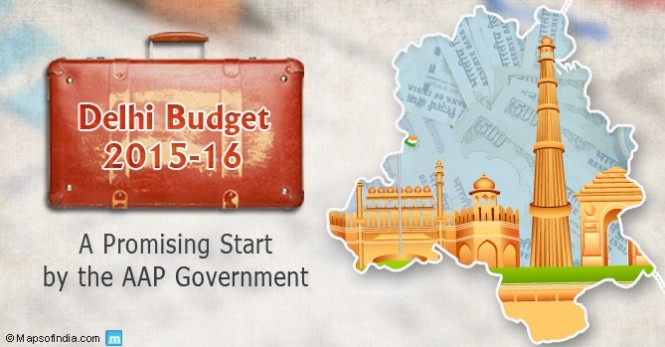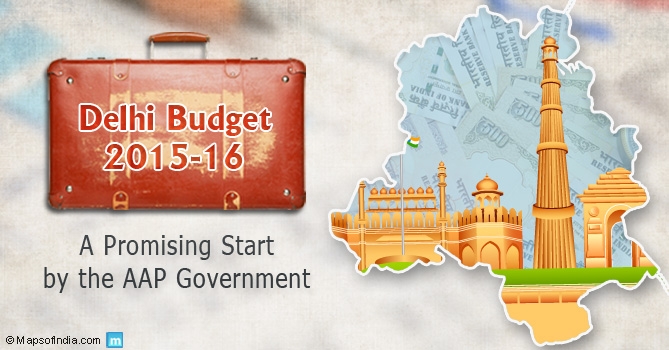 On 25 June 2015, Manish Sisodia, Deputy Chief Minister, presented the 2015-16 Annual Budget for Delhi, terming it as India’s first ‘Swaraj’ budget. For a government that has been facing a lot of criticism for not getting its act together, the budget came as a pleasant surprise to many for its focussed thrust on sectors that are both popular and necessary for the common man of Delhi.
On 25 June 2015, Manish Sisodia, Deputy Chief Minister, presented the 2015-16 Annual Budget for Delhi, terming it as India’s first ‘Swaraj’ budget. For a government that has been facing a lot of criticism for not getting its act together, the budget came as a pleasant surprise to many for its focussed thrust on sectors that are both popular and necessary for the common man of Delhi.
Most state budgets spread themselves thin trying to please too many constituencies with limited allocations and focus more on measures that are high on populism but low on fiscal pragmatism. The AAP government in Delhi has rightly decided to take on their critics who were very vocal in criticising the party for over promising in its poll manifesto, promises that would be difficult to implement on account of low availability of finance. So rather than spread its limited resources over too many areas, the state government has decided to prioritise its focus on areas that need the most attention and benefits of which would be most visible to the common man of Delhi.
The biggest gainers in this budget have been education, transport and health sectors.
The Deputy Chief Minister highlighted the government’s focus on building Delhi as a preferred city that would be graft-free and e-enabled, and where investment would be welcomed through ease of doing business and increased availability of skilled people. The Budget also stands out for the fact that it is the result of inputs received through various ‘Mohalla Sabha’ held in various parts of Delhi and has included suggestions made by the people of Delhi, based on their priorities.
If the government is successful in optimising its investment in the stated sectors and backed by efficient implementation, the results are bound to show in the near future and that would be a sure step in gaining back people’s confidence, while simultaneously placating its various critics who accuse the party for not getting its act together.
Let’s look at the sector-wise allocation thrust in the 2015-16 Budget. The total proposed Budget for FY 2015-16: Rs 41,129 crore, which is 18% higher than the Revised Budget of Rs 34,790 crore estimate presented in FY 2014-15.
• The Plan Budget is: Rs 19,000 crore (46%)
• The Non-Plan Budget is: Rs 22,129 crore (54%)
Education (General Education, Technical Education, Art & Culture, Sports & Youth Services)
The state government has accorded top priority to education and rightly sees this as an investment into the future. Education receives the largest allocation of Rs 4,570 of the Plan Outlay, which represents a 24% share and marks an increase of 106% over last year’s expenditure of Rs 2,219 crore. No state has earlier doubled the allocation on education in a single year and the Delhi government can take full credit for identifying education as the ‘transformational’ sector that will show the maximum impact in developing future Delhi.
Delhi has had a woeful record in the education sector with very poor infrastructure and teacher-student ratio. To address this, the Delhi government is planning to develop 50 schools as Model schools, which will have vastly improved facilities and infrastructure. Over a period, all 1011 schools will be developed on similar lines. To mitigate the stress of admissions in schools, the government is planning to setup 236 new schools.
To address the teacher-student ration problem and reduce the burden on over-worked teachers, the government plans to recruit 20,000 new teachers by the end of the year.
To incentivise and promote higher education, the government is planning to launch a ‘Higher Education and Skill Development Guarantee Scheme’, whereby a student can receive a loan up to Rs 10 lakh without putting up any collateral or margin money. This facility is expected to go a long way in helping students from economically weaker backgrounds and enable them to pursue higher education.
The government is also planning to set up a ‘Skill’ University that will focus on developing vocational skills. A sum of Rs 310 crore has been earmarked for this. Three new ITIs and five new Polytechnics are proposed to be set up, while Netaji Subhash Institute of Technology will be upgraded to a University and the student strength increased from the existing 3000 to 12,000, over five years.
Transport
Transport takes the 2nd largest share with Rs 3,695 crore, which represents a 19.45% share of the Plan Outlay. Giving public transportation the highest priority, the government plans to introduce 1,380 semi-low floor and 500 mini buses under DTC. 1000 buses under the Cluster Scheme will also be added, to be deployed by end of 2016.
Over 10,000 buses run by the private sector are proposed to be introduced under the PPP Cluster Scheme. Another 304 mini buses will be introduced this year on 64 Metro feeder routes, to improve last mile connectivity. To match the expansion in bus fleet, the government is planning to construct 1200 new bus shelters.
The government is also planning to release 5,500 new Auto permits, while promoting the use of e-Rickshaws. The government plans to offer Rs 15,000 subsidy on e-Rickshaw purchases.
To enhance safety and security, the government plans to introduce GPS tracking on all autos and taxis. In addition, all DTC and Cluster buses will carry CCTVs and each bus will have a Marshal in charge of security. This is expected to go a long way in making people feel more secure and reduce crime.
Medical and Public Health
Improving health infrastructure and services was a major poll promise of AAP. The government is now giving it the requisite thrust by allocating Rs 3,138 crore or 16.52% share, which makes it the 3rd highest allocation in the Budget.
Delhi’s public health infrastructure and services have been overburdened with a growing population and low finance allocation. This has been largely addressed in this Budget and the people of Delhi are going to welcome this sector getting its due priority.
Health infrastructure will be greatly enhanced with the addition of three new hospitals at Nangloi, Madipur and Sirsapur with a total bed capacity of 1800. 11 existing hospitals will be upgraded to add 4000 new beds over the next two years.
In an attempt to take medical services to the common man, the government is proposing to set up 500 ‘Mohalla Clinics’ this year. These clinics will be supported by five centralised diagnostic labs located in different zones in Delhi.
With Delhi increasing its presence as a major sporting city, an Advanced Trauma Care Facility with 100 dedicated Trauma beds including ICU and OT, is planned at LN Hospital to address the specialised needs of those who suffer sports related injuries.
To ensure that the poor and weaker sections get access to private medical care, the government plans to introduce online booking of free bed facility at 42 private hospitals in Delhi. Furthermore, the government will provide free medicines through various charitable clinics and dispensaries.
Social Security and Welfare
AAP has always positioned itself as a party for the common man and towards this the Budget allocates Rs 2,347.50 crore, which represents a 12.36% share of the overall Plan Outlay.
Continuing with its policy to subsidise electricity and water, the government has allocated Rs 1,690 to meet its subsidy commitment.
The government proposes to build five new Old Age Homes at Chittranjan Park, Chattarpur, Rohini, Paschim Vihar and Kanti Nagar.
In participation with the private sector, six new Working Women’s Hostels are also to be constructed.
The Slums and JJ clusters of Delhi have traditionally been ignored for most facilities. The government plans to establish 300 crèche facilities under the Integrated Child Development Scheme, which will help women from the weaker sections to work without worrying about their infants and young children.
Employees of several support arms of the government like the Delhi Police, Fire Department, Home Guards and Civil Defence, who lose their lives in line of duty, will now receive rupees one crore compensation from the state government. This will apply to Military and Paramilitary personnel from Delhi as well.
Farmers who suffer crop damage on account of weather, will now receive an ex-gratia relief of Rs 20,000 per acre. This also happens to be one of the highest compensations by any state government to farmers.
Other Sector allocation
Urban Development and Housing receives Rs 1,793 crore (9.44% share), Water Supply and Sanitation – Rs 1,468 crore (7.73%), Energy – Rs 645 crore (3.39%), other Administrative Services – Rs 582 crore (3.06%), Public Works – Rs 205 crore (1.08%), Rural Development – Rs 189 crore (0.99%), Science Technology & Environment – Rs 101.20 crore (0.53%), Jail – Rs 80 crore (0.42%), Industries – Rs 67 crore (0.35%), Minor Irrigation and Flood Control – Rs 65 crore ( 0.34%), Tourism – Rs 41 crore (0.22%), Agriculture and Allied Services – Rs 9 crore (0.05%), and Secretariat Economic Services – Rs 4.30 crore (0.02%).
Efficient execution must now be the priority
The Delhi administration has made a good start with the right thrust. The government must now ensure that the allocated funds are released in a timely and transparent manner and all projects monitored efficiently for quality and timelines.
If the government succeeds in implementing all planned projects, AAP would once again emerge as a serious contender for the voter mindshare not just in Delhi but beyond.





